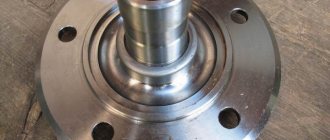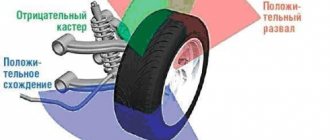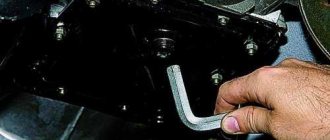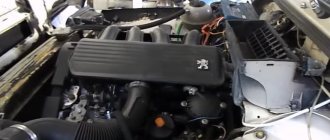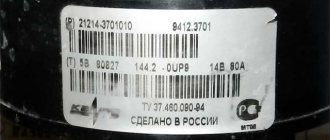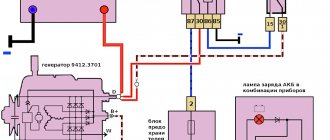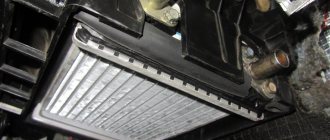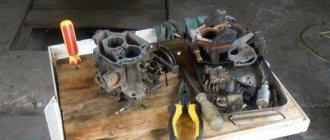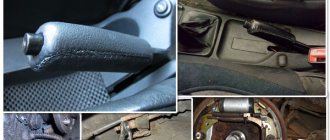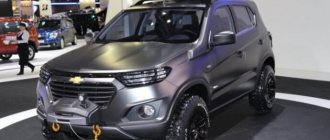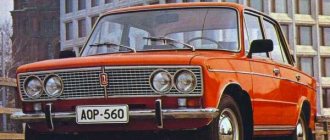Adjusting Niva fog lights
The Niva's fog headlights are also adjusted manually.
To do this, we rotate each headlight vertically and horizontally until it meets our standard. Of course, you should first unscrew the mounting bolts a little for practicality and ease of setup. After completing the procedure, do not forget to tighten the bolts again. Remember that it is strictly forbidden to adjust the light beams so that they blind oncoming drivers. For such an act, you can safely receive an administrative fine for obstructing the driving of oncoming traffic. The fine starts from 500 rubles. The amount is not large, but the human factor plays a greater role here.
Remember the main thing is that if the body of the Chevrolet Niva is not damaged, the optics are intact, then there is no special need to adjust the headlights. Sometimes they resort to tuning when the owner intends to tune the car with non-standard equipment.
In such cases, a new mounting socket can be cut out, optics with a completely new shape can be installed, and new electrical power cables can be pulled. But that's a completely different story.
The video below shows how to adjust the headlights of a Chevrolet Niva with your own hands, taking into account the angle of incidence of the headlights.
Over time, a Chevrolet NIVA car owner may be faced with the need to adjust the high and low beam headlights, as the quality of light reflection gradually becomes worse.
At night, visibility and vehicle control depend on how bright the optics are.
Therefore, the importance of the correct placement of lighting is very important for every driver.
In what cases is adjustment required?
When purchasing, you receive a new Niva with perfectly adjusted lighting - light at one point, without glare. But over time, these settings are violated. Poorly adjusted headlights can create significant interference when driving at night, in rain, fog, and in winter. An unexposed light “illuminates” the space in front of the car, thereby creating a negative effect. The light curtain interferes with the driver's view and blinds oncoming cars. Xenon headlights can cause problems for vehicles ahead.
What can cause a violation of the factory settings:
- damage to headlights followed by replacement;
- part repair;
- changing light bulbs;
- installation of halogen and xenon lamps;
- an accident resulting in a violation of the body geometry;
- installing tires of a different height and width;
- replacing front springs;
- repair of the front part of the Niva.
A check will also be required if such a procedure has not been carried out since the date of purchase. Over time, the position of the light beam gets lost. This is caused by frequent driving on uneven roads. If you have difficulty seeing the roadside at night or your friends complain that the Niva’s optics are blinding, it needs to be adjusted.
Checking the optical adjustment is mandatory when purchasing a used car. The previous owner of the Niva could have had an accident, and then had to level the body with putty or adjust the headlights on his own, without the proper mechanic skills.
To determine if the headlights are not adjusted correctly, place the car in front of a wall and turn on the lights. The light rays will be directed in different directions - up, down, or spread to the sides, but not to one point. Such a simple check will be a signal to urgently adjust the headlights. It is quite possible for the driver to set the Niva’s luminous flux correctly independently.
What headlights should I put on my car?
Niva 2121 4x4 headlights, sidelights, and other optics allow you to increase visibility on the road at night. Thanks to internal optics, the car owner has the opportunity to illuminate the interior of the 2121 4x4 and other components of the car. In addition, with the help of headlights, the driver can warn other motorists about what maneuver he plans to make. Accordingly, a lot depends on the quality of the headlights in the 2121 4x4 model, especially since each optical element performs a specific function.
Tuned lights and sidelights for Niva
The 2121 4x4 headlights or taillights can use a variety of bulb types.
As a rule, these are gas-discharge elements, which can be of the following types:
- incandescent or halogen, which today are considered one of the most common options, can be used for both low and high beam lighting;
- xenon - one of the most modern options, can also be used for high or low beam lighting;
- tungsten - the cost of such devices is the lowest, but their quality of light intensity is not high.
Recently, Niv 2121 4x4 car owners have been practicing the use of LED bulbs in crystal headlights. Moreover, they are used not only for signal options, but also as a source of main lighting. In fact, LED elements are brighter, unlike halogen and xenon, and by about 300%. Moreover, the density of light fill in this case is also higher. LED headlights are suitable for those Niva 2121 4x4, the headlight size of which is 7 inches.
Tuning headlight for Niva
Installing modern tuned headlights on a Niva 2121 is not a difficult procedure. Moreover, over time, many car owners of domestic SUVs come to this in order to improve head lighting. Indeed, recently more and more optics manufacturers have appeared on the domestic market, which can boast of high-quality flashlights. There are many options for purchasing from a Niva 2121 car owner - these can be either crystal or tank options; the choice of manufacturer depends solely on the preferences of the motorist and his financial capabilities.
As practice shows, many 21213 owners choose Wesem brand headlights. Such optics can be easily installed instead of standard ones. Such lights are ideal for domestic SUVs - they can be installed in ten minutes, especially since such optics are characterized by good lighting compared to traditional ones. Flashlights of this type are ideal for 21213 and 21214; they are equipped with 12 or 24 volt bulbs.
As for fog optics, the Wesem brand offers car owners such lights. If you believe the reviews, the anti-fog elements are characterized by a clear outline of the lighting boundaries - both lower and upper. Accordingly, thanks to this, the owner of model 21214 has the opportunity to correctly configure and adjust in accordance with GOST. In fact, fog lights practically do not blind drivers of oncoming cars; in combination with low beams, they can provide better lighting.
Niva headlight
About the reasons for violation of regulations.
Cars have correctly configured headlights. Unfortunately, these options are violated. There can be many circumstances for this, for example:
- Violation of body geometry
; - Replacing headlights;
- Front suspension repair;
- Installation of other rubber on wheels.
The luminous flux of the headlights will be directed up or down, or even to the sides. That 2121 has permanent all-wheel drive, they drove in the field to the recreation area, as we see. Sometimes inappropriate and inept intervention by car owners leads to lighting problems. In any of these cases, you need to adjust the light.
See:
Replacing low beam lamps on a Chevrolet Niva — Chevrolet Niva, 1.8 l., 2011 on DRIVE2
Hi all!
Yesterday the left low beam bulb burned out. Yes, left again. I don’t know why this happened, but the left lamp is always the first to go out. I always change both at once.
Not because I’m a bourgeois, but so as not to have to explain to the traffic police later “why my headlights are shining differently,” and not have to poke around again, proving that I didn’t “do anything illegal” there.
In addition, the second lamp also has a damaged filament and will not last long anyway.
So I change both. Last time it was Osram Night Breaker. As in the picture below. No complaints, except for the price of 1,700 rubles. They lasted for 2 years despite the fact that I did not install separate running lights.
I always turn on the low beams. I can also note that they shine with white light, which creates a certain comfort when driving at night. Well, the declared brightness of 120% seems to be fulfilled, although this is only “by eye”.
I did not measure with instruments.
Osram Night Breaker
This time I could have bought them too, but I found others on sale: Philips Racing Vision with a declared brightness of 150%. It’s not that I’m a fan of brightness, but it’s always nice when the headlights shine well, it’s easier on the eyes.
They say that this makes the lamps have a shorter lifespan, but judging by the Osrams, they lasted 2 years. I can’t say that the original lamps worked longer. Price for Philips = 1400 rubles.
Let's see how they shine and how long they last.
They look like this:
Full size
Philips Racer Vision
Full size
Philips Racer Vision
For those who are just studying the design of the Chevrolet Niva, I will say that replacing lamps is elementary. No trip to service required.
Remove the rubber boots from the back of the headlights (it’s impossible to make a mistake there), remove the terminals from the lamp (remember the colors of the wires, they are different), press the spring down and to the side and the lamp snaps off. Put the new one back in the same way (do not touch the glass! so as not to get it dirty).
It is inserted into the socket in the only correct way. There is a special “tongue” for this. Don't get confused. Then you snap it on. Put on the wiring. Close the anthers. To replace the right headlight, you will need to unfasten it for a while and move the barrel with the washer. Nothing complicated.
But you will be sure that you will have exactly your good, expensive lamps. And sometimes it happens that at the service they put not what you brought, but something “other”...
Thank you for your attention!
Issue price: 1,400 ₽
Automatic correction
Even the most accurate manual correction is inferior to automatic adjustment. Using auto-correction, you can achieve better performance. This will also affect the subsequent operation of the Niva. Auto-correction is recommended when xenon or halogen headlights are installed.
The main advantage of an automatic corrector is that the light beam is set and maintained in accordance with road conditions. The nature of the vehicle's movement is taken into account. Namely:
- driving on uneven roads;
- turns right, left;
- braking;
- going uphill.
The automatic corrector consists of:
- 2-3 ride height sensors (installed front and rear);
- electronic unit;
- actuators.
Using the block, the ground clearance of different axles of the Niva is monitored. Those. it automatically detects body tilt. This data is processed and the headlight angle is adjusted.
How to install autocorrector on Niva:
- The headlights are removed.
- The old manual corrector is removed.
- The new sensor socket is secured with sealant.
- A headlight corrector is installed in it.
- The ground clearance sensor is attached to the bottom.
- The device wire is pulled through a tunnel with tubes.
No additional adjustments are necessary. The headlights will adjust themselves, taking into account the load of the Niva and the nature of its movement. The installation itself will take no more than 10 minutes. The only drawback of this device is its high cost. The cost of an electromechanical corrector starts from 1,700 rubles, but for installation you only have to buy a sealant.
As you can see, Niva owners can independently set the beams of light on the headlights without using improvised means. The main thing is to strictly follow the instructions and prepare the test site correctly.
On the one hand, we can agree with this, because what kind of security can we talk about if there is no decent coverage. But on the other hand, some cars have optics installed by the manufacturer themselves, which do not shine with quality and fine-tuning.
This applies to a greater extent to domestic cars. And if the car has a solid mileage, then there is no point in further discussion at all. We know that with every ray of sunlight, optics fade and become duller. The ability to qualitatively reflect the light of lamps in headlights is gradually decreasing.
Moreover, an accident or traffic accident can lead to damage to the body part and the geometry of the frame will be disrupted. Regardless of whether the optics are new or old, they will shine worse.
Adjustment
As for adjustment, this is also quite an important point. There are several options for adjusting the optics - all of them are described in detail here. If necessary, you can purchase a special electric corrector designed to change the angle of the light beam. Such an electronic device automatically sets the required tilt angle depending on the load on the car. By design, such a device includes a regulator for fixing the position of optical elements, as well as several mechanisms with seals and electrical wires.
Do-it-yourself headlight adjustment Niva 21214 video
Niva all-terrain vehicle. Adjusting the headlights
| 1, 7 – screws for adjusting the direction of the headlight beam; 2 – optical element; 3 – screw for fastening the rim of the optical element; | 4 – decorative lining of the front of the body; 5 – screw for fastening decorative cladding; 6 – rim of the optical element |
The direction of the light beams of the headlights should be such that the road in front of the car is well illuminated, and oncoming drivers are not blinded when the low beam is turned on.
The headlights are adjusted by rotating screws 1 and 7, which rotate the optical element in the vertical and horizontal planes.
It is most convenient to adjust the headlights using mobile optical devices. If they are not there, then adjustments can be made using the screen.
Niva all-terrain vehicle. Headlight adjustment diagram
Place a fully fueled and equipped car, with a load of 735 N (75 kgf) on the driver’s seat, on a flat horizontal platform 5 m from a smooth wall or any screen (plywood panel measuring about 2x1 m, etc.) so that the axis of the car was perpendicular to it. Before marking the screen, make sure that the air pressure in the tires is normal, and then rock the car sideways to install the suspension springs.
Draw vertical lines on the screen: center line 0 and lines A and B passing through points E, corresponding to the centers of the headlights. These lines must be symmetrical with respect to the center line of the vehicle. At a height corresponding to the distance of the centers of the headlights from the floor, draw line 1 and 65 mm below it, line 2 of the centers of the light spots.
If the car has a hydraulic headlight leveler, then set its handle on the instrument panel to a position that corresponds to the vehicle load of one driver.
Turn on low beam headlights. Sequentially, first for the right headlight (the left one is covered with a piece of cardboard or dark matter or is turned off), and then for the left one (the right one is closed), adjust the light beams of the headlights with screws 1 and 7 (see Fig. Adjusting the headlights).
A little about how the 21213 Niva is adjusted.
If the car is equipped with a hydraulic headlight leveler, then they can be adjusted using it without leaving the vehicle interior.
The photo above shows the hydraulic corrector's executive body. The position of the headlight reflector is adjusted by changing the length of the rod, which changes under hydraulic pressure.
If the front suspension elements have been replaced, or the type of tire has been changed, the adjustment can be done on your own.
Adjusting Niva fog lights
The Niva's fog headlights are also adjusted manually. To do this, we rotate each headlight vertically and horizontally until it meets our standard. Of course, you should first unscrew the mounting bolts a little for practicality and ease of setup.
After completing the procedure, do not forget to tighten the bolts again. Remember that it is strictly forbidden to adjust the light beams so that they blind oncoming drivers. For such an act, you can safely receive an administrative fine for obstructing the driving of oncoming traffic. The fine starts from 500 rubles. The amount is not large, but the human factor plays a greater role here.
Remember the main thing is that if the body of the Chevrolet Niva is not damaged, the optics are intact, then there is no special need to adjust the headlights. Sometimes they resort to tuning when the owner intends to tune the car with non-standard equipment.
In such cases, a new mounting socket can be cut out, optics with a completely new shape can be installed, and new electrical power cables can be pulled. But that's a completely different story.
The video below shows how to adjust the headlights of a Chevrolet Niva with your own hands, taking into account the angle of incidence of the headlights.
Over time, a Chevrolet NIVA car owner may be faced with the need to adjust the high and low beam headlights, as the quality of light reflection gradually becomes worse.
At night, visibility and vehicle control depend on how bright the optics are.
Therefore, the importance of the correct placement of lighting is very important for every driver.
A short guide on how to adjust the light of a Niva car
Properly adjusted headlights on a vehicle are a prerequisite for safe driving at night.
It is not very pleasant, and even unsafe, to move along the road at night, when oncoming traffic blinds you to the point of darkness. But it may happen that your car also causes inconvenience for other road users.
Poor visibility for the driver while driving may also be a reason to check the adjustment. Light problems can make it difficult to pass annual technical inspections. Therefore, such a check should become a rule for all drivers.
To improve road illumination, we can recommend additional lighting in the form of fog lights.
How to adjust headlights
To adjust the optics on the Niva 2121, you must:
- Understand the design of lighting devices.
- Prepare tools and materials.
- Place the Niva on a flat surface.
- Draw a diagram using a test panel.
You can study the Niva optics using the manual. Instructions are issued when purchasing a car. If you are the owner of a used car, then the manual can be found on one of the thematic sites.
Required tools and materials
Tools you will need:
- Phillips screwdriver;
- shield to cover the headlight.
It is also recommended to check the tire pressure and fill the car with gasoline to a certain level. Add antifreeze and washer fluid. A load equal to the driver's weight should be placed on the front seat. Remove the spare tire and large, heavy items from the trunk. Those. it is necessary to bring the Niva into full “combat” condition, in which it is most often used.
In addition to the tools, it is necessary to prepare a site for testing. It will serve as an adjustment stand. She may find herself:
It is necessary to draw an adjustment diagram on the stand. It is the same for all vehicles.
Step-by-step instructions and work diagram
As already mentioned, the first step is to draw markings on the test bench. This is done like this:
- Draw an axis of symmetry in the middle of the stand.
- Draw two straight lines from the floor to the end of the stand. They should be exactly in the center of the headlights.
- Draw two parallel lines. The height of the first is equal to the level above the floor, the second is 120 mm. If a hydraulic corrector is installed, reduce the height by 65 mm.
- We set the hydraulic corrector handle to the minimum load position.
Make sure that the surface of the area where the car is located is flat, without slopes or elevations.
Now about how to adjust the headlights:
- We place the Niva in front of the stand. Distance – 5 meters.
- We clean the optics with ethyl alcohol.
- We start the car. Otherwise the battery may run out.
- Turn on the low beam.
- Open the hood.
- Covers one of the headlights with a special shield.
- We expose the beams in a vertical direction. Take a Phillips screwdriver and turn the adjusting screw. It is located on the side of the radiator grille. Turn the screws in the same direction by the same number of turns. Error allowed, maximum three clicks.
- Adjusting the horizontal plane. To do this, the same screws are used, only now they need to be rotated in the opposite direction. The first is counterclockwise, the second is clockwise. We make revolutions at the same time.
- During the rotation process, we achieve the effect of placing the light beam no higher than the horizontal line of the shield. The inclined line should intersect with the lines in the vertical direction at the centers of the right and left parts.
- We set the light on the second headlight of the Niva car.
- We check the adjusted elements first on the stand, then on the road.
Even the most accurate manual correction is inferior to automatic adjustment. Using auto-correction, you can achieve better performance. This will also affect the subsequent operation of the Niva. Auto-correction is recommended when xenon or halogen headlights are installed.
The main advantage of an automatic corrector is that the light beam is set and maintained in accordance with road conditions. The nature of the vehicle's movement is taken into account. Namely:
- driving on uneven roads;
- turns right, left;
- braking;
- going uphill.
The automatic corrector consists of:
- 2-3 ride height sensors (installed front and rear);
- electronic unit;
- actuators.
Using the block, the ground clearance of different axles of the Niva is monitored. Those. it automatically detects body tilt. This data is processed and the headlight angle is adjusted.
How to install autocorrector on Niva:
- The headlights are removed.
- The old manual corrector is removed.
- The new sensor socket is secured with sealant.
- A headlight corrector is installed in it.
- The ground clearance sensor is attached to the bottom.
- The device wire is pulled through a tunnel with tubes.
No additional adjustments are necessary. The headlights will adjust themselves, taking into account the load of the Niva and the nature of its movement. The installation itself will take no more than 10 minutes. The only drawback of this device is its high cost. The cost of an electromechanical corrector starts from 1,700 rubles, but for installation you only have to buy a sealant.
As you can see, Niva owners can independently set the beams of light on the headlights without using improvised means. The main thing is to strictly follow the instructions and prepare the test site correctly.
source
We adjust the headlights ourselves
It is quite possible for the driver to choose and install the required luminous flux on the car with his own hands. To do this, you need to have an understanding of the design of lighting devices and the principles of their adjustments. Such data is described in the vehicle’s operating instructions, and there is also a description of such a procedure.
Attention! To begin work, you need to prepare a tool and a flat area.
All you need is a Phillips screwdriver and a shield to cover the headlight. The tire pressure is checked in the car; the instructions may regulate a certain amount of fuel in the tank, as well as the installation of a load on the front seat, which must correspond to the driver’s weight.
Lamp selection
Type
So, if the low beam light on your car does not light up, then most likely the reason for this is its burnout. Accordingly, before you decide to replace it, you need to select and purchase a new lamp.
To do this, first of all, you need to figure out which low beam lamp is installed on the Niva Chevrolet. There are two types:
| Lamp type | Peculiarities |
| H4 | Double-filament (high and low beam combined) |
| H7 | Single strand |
H7 standard halogen bulb
In our case, we will need an H7 low beam lamp - on the Niva Chevrolet, the headlight unit is divided into two compartments, respectively, separate single-filament bulbs are used for low and high beam lighting.
Xenon bulb H7
What to look for when choosing
Of course, in addition to the design type of the lighting element, it is also necessary to pay attention to some of its characteristics. The most important parameter is the luminous flux power
It largely depends on the operating principle of the lighting element.
Below is a comparison of the power of light fluxes per watt of power of different types of lamps:
| Lamp type | Luminous flux power, 12 lm/W |
| Incandescent | 12 |
| Halogen | 16 |
| Halogen with quartz glass | 24 |
| Xenon arc | 91 |
| Light-emitting diode | 132 |
| Sodium gas discharge | Up to 200 |
Not only the power of the luminous flux, but also its price depends on the operating principle of the lighting element. The most affordable are halogen bulbs, and the most expensive are xenon and LED.
In the photo - LED light bulb
It should be noted that in addition to being cheap, they also have other advantages:
- Good light penetration. Therefore, they illuminate the road better than others in bad weather.
- They do not require the installation of additional equipment, unlike LED and xenon ones. Therefore, it is not difficult to replace the light bulb yourself.
Therefore, despite the lower brightness and yellowish color of the light flux, they are the most common.
Headlamp diagram
Repair of fog light adjustment on a Chevrolet Niva
Until recently, I didn’t have fog lights; I only drove with the main headlights. Although no, I have a connector on the bumper for the PTF on my Chevrolet Niva, there are even fog lights, but they are rusty and have not worked for me since the purchase. I suddenly changed them for new ones, I just went to the store, bought a spare part, but it turned out that it was much cheaper than I expected, so I decided to buy fog lights with the rest. It turned out that they really help improve visibility, especially in bad weather conditions. And now there is no need to constantly turn on the low beam.
And during a hunting trip, I had to drive in very hard-to-reach places, and that’s where I broke my foglight adjustment. The PTF fasteners were also damaged, but I repaired them the very next day. The adjustment also needs to be fixed, because the bulbs themselves are very bright and, during normal driving, I point them down, but when driving through the forest, when there is not enough light, I lift the PTF up to give more light. We recommend:
I didn’t want to change the entire adjustment system; I needed to come up with some simple repair method. After thinking everything over, I realized that ordinary zip ties can help me with this. I dismantled the fog lights on the car, and replaced the main screw in place of the standard adjusting screw. After this, carefully place a piece of belt on the screw, bend it at the installation site and fasten it to the plastic with a so-called bug. After that, I manually checked whether the adjustment worked. The travel of the fog lights ended up being 5 millimeters. The entire structure was assembled and installed in place.
Now you need to adjust the PTF for civilian driving so that the lighting does not blind oncoming drivers. I made marks on the garage door, parked the car on an even level and turned on the fog lights. Yes, there is a slight flare left. Unfortunately, I did not take into account that the iron fastening of the PTF was also slightly adjusted as a result of the collision with the pit. Here everything is easily solved, you just need to bend the holder correctly with your hands and then the flare will disappear.
Dismantling
In some cases, in order to correctly adjust the light beam or as a result of mechanical damage, you need to remove the headlight, this is also due to the fact that over time the lamps become cloudy, as a result the power of the luminous flux deteriorates. If you don’t know how to remove a headlight on a Chevrolet Niva, you need to prepare a standard set of tools and do the following:
- Remove the terminals from the battery;
- The decorative lining of the radiator is removed; to do this, self-tapping screws are unscrewed from its mounting, which is located under the license plate;
- The power wires are disconnected from the light element;
- The wires from the hydraulic light corrector are disconnected;
- The front and right mounting screws are unscrewed from the headlight; for this, a ten key is used;
- The screws that secure the decorative trim of the headlight are unscrewed, after which it is removed;
- Unscrew the screws that are located under the cladding;
- The headlight is removed from the seat; if the fastenings are difficult to press out, you can use a screwdriver.
At this point, all work can be considered completed. Assembly is carried out in reverse order.
You should know that when replacing halogen lamps, it is not advisable to touch the bulb with your fingers, so you need to work with clean gloves, otherwise they will begin to become cloudy; if you do touch it, you need to wipe it with an alcohol rag.
A few words about adjusting the light on the stand
All vehicle operating instructions recommend making such adjustments on a special stand. How to remove headlights on a Nissan Qashqai. However, in some cases this operation can be easily performed independently. In cases where body repairs were carried out to restore body geometry
, it is best to contact the service and perform this procedure using a special stand.
The photo shows one of these stands. It is a stand that rotates freely in any direction. A system for laser centering of the light beam, a glass lens with a lux meter, and a mirror for precise positioning are placed on it.
Now on my third Niva I am faced with the problem of the headlight beam being too low. Even in the highest position of the hydraulic corrector, the headlights on the low beam shine low, almost under the bumper. The solution came after removing the optical element. Having disconnected it from the block with wires and put it aside, we see the headlight housing. A hydraulic corrector is installed below:
It is clear that in order to raise the light beam higher, you need to lengthen the hydraulic corrector pin, which rests on the headlight housing. A cap from the cheapest ballpoint pen is ideal for this.
We take two identical caps (this is important because
different caps have different internal diameters and different tapers) and cut it into two parts about 3 mm above the place where the clothespin attachment ends on the cap (aka the pin for holding the pen in your pocket):
Then we put the cut off tips of the caps on the pins of the hydraulic corrector:
Before this, you need to lower the headlights as far as possible using the hydraulic corrector, otherwise the caps may not fit between the pin and the housing. All! Work is done. We install the optics in place. Now the hydraulic corrector can be set to the middle position. The headlights will shine optimally. At the same time, we have the opportunity to adjust the headlights both up and down. Since, as I said above, the internal diameter of the caps varies, it may be necessary to cut a little further from the pin, about 5 mm from it. This is already being done experimentally. That is, we first cut off at a distance of 3 mm, if after installing the caps on the hydrocorrector pins the light is too high, then remove the caps and trim them another couple of millimeters.
From the Lead FAQ. Such an operation should be performed only after the standard adjustment with the screws on the right and left of each headlight has proven insufficient. In this case, each pair of screws for each headlight must be screwed in the same way.
How to properly adjust Niva headlights
In total, there are three main methods that are used for adjustment:
- Seek help from experienced mechanics. Not in our case, since we want to learn how to do everything with our own hands;
- apply a special technique to adjust the headlights;
- adjust by eye to a spot on the road.
Also interesting: Niva tuning: 145 photos of ideas on how to improve the VAZ 2121 with your own hands
The second option is the most acceptable for all car owners.
The whole process can be described in three points:
- markings on the wall,
- applying headlights to the wall,
- line adjustments and fine superstructure.
There is no point in starting to adjust the Niva's headlights if there is deformation of the body.
Must be checked:
- tire pressure. It should be within the permissible norm - for a Chevrolet Niva it is 1.9 bar for almost all tire sizes;
- springs and transmission are in good condition;
- even distribution of load on the chassis. It is prohibited to carry out adjustment work if the machine is under a load that is unevenly laid on the chassis.
If you do not work through the above points, the setting will be completely incorrect and later you will have to redo the entire headlight setting again.
Algorithm for adjusting headlights of Niva Chevrolet
Before starting, you should thoroughly wash all Niva optics. It is necessary to wipe it, and if there are defects or damage, replace it with a new one. The slightest crack or chip will not give the desired result in adjusting the light.
From the inside of the hood we find two adjusting bolts on the body. One is responsible for horizontal adjustment, the second is responsible for vertical adjustment. Alternate twisting will lead to precise alignment of the light beam to the proper level. Sometimes it happens that a few millimeters are missing from the long-awaited level.
In this case, you should place several washers at the base of the housing mount. To do this, you need to dismantle the headlight, put a couple of washers on the plug mounts and install the optics again in their original place. Step-by-step instructions on how to adjust Chevrolet Niva headlights:
- We find a flat area with a flat wall;
- prepare tape and chalk for drawing lines on the wall;
- we drive up to a distance of 2 meters to the wall;
- do not turn off the engine, turn on the low beam;
- squeeze the handbrake for safety;
- set the headlight range control to the middle position, if available;
- Mark the center of the light beam of each headlight with chalk. This can be done either with chalk or in the form of crosses with tape;
- we drive away to a distance of 5 meters;
- We connect the previously obtained points exactly with a line;
- exactly in the middle of the resulting segment we draw a vertical line, indicating the middle of the body part of the technical device;
- below, at a distance of 7 centimeters, draw a line called a secant;
- turn on the low beam;
- in the hood we find adjusting screws in the headlight plastic housing. We begin to twist them little by little so that the light beam lies exactly between the horizontal line and the secant line;
- Now that the low beam is set, let's move on to the high beam. Ideally, the high beam will not have to be adjusted;
- Under normal operating conditions, the lighting quality should improve. If this does not happen, then look for the reason for the violation of the body geometry. There may have been an accident or accident that you don't know about.
Read more: 169 Which region of Russia
Chevy Niva headlight adjustment
Over the summer I installed PTF, but did not make any adjustments to the headlights; it was enough that they just shine. Until recently, it was not necessary to use PTF very often, since the weather was not particularly damp and the road in the dark on poorly lit city streets was quite clearly visible, but recently the weather has become damp, either rain or snow, respectively. In order to better see what is happening in front of the car, I often turned it on together with the low beam and PTF. Everything would be fine, especially together with the low beam, but separately the PTFs shined only right under the nose, illuminating no further than 10 meters in front of the car. Having read the instructions for the PTF, I didn’t understand anything, since it says that the headlights at a distance of 25 meters should shine 0.5 meters below their axis. How is that?! On the wiring box it is written that the upper limit of the light should be at a distance of 10 meters and 5 cm below the axis. But my wiring was not ShNivovskaya, but from a VAZ-2115, and to believe what was written, well, I don’t know... I started looking for information on adjustment, but I didn’t find anything clear. Either they say that, according to GOST, PTFs should shine no further than 15-16 meters, then you need to calculate the angle of inclination to be half that of the head light. I looked at the latest manual for the Shniva, and there’s some terrible writing there...
In the earlier edition, everything was somehow stated more simply.
That's what he used. I gathered my courage, took a friend with me, grabbed a set of Torx keys, a tape measure and chalk, and went in search of a more or less suitable place with a more or less level area and a wall. We found and measured 10 meters from the car to the wall (in principle, 5 meters would have been enough, as according to the manual, but at 10 the picture of how the PTF lights look better to understand how the light is distributed), unfortunately the area turned out to be not entirely level, slightly convex , but that didn't really bother me. First, let’s look at how our PTFs generally shine.
It seems that the border of light is even, but, as expected, the headlights shine a little low. I measured the height from the ground to the middle of the PTF glass, it turned out to be about 47 cm, I measured the same amount on the wall from the edge of the shadow from the convexity of the platform, drawing a horizontal stripe with chalk. The manual says that the upper limit of the PTF light should be at a distance of 10 meters at the same height as measured, or slightly lower. We take a Torx T20 wrench and use it to feel for the sprocket of the PTF adjusting screw.
We close the right headlight and raise the left one so that the upper limit of the light is at the level of the strip drawn in chalk on the wall; we do the same with the right headlight. This is the result.
My PTF is a little splashed with dirt from the road, especially the right headlight, so the edge of the light is a little blurred, but it turned out not bad, the headlights now shine as they should. Ideally, of course, the area for adjusting the headlights should be perfectly level, the pressure in the wheels should be uniform - 1.9 atm, a full tank of gasoline and the driver in his place, and, of course, clean headlight optics... But these are too ideal conditions that are difficult create, and there is no need for them, it is enough to make the adjustment in such a way that it suits you and does not blind oncoming drivers
Tuning of optical elements of Niva 21214
To clearly stand out on the road among similar cars, it is possible to install tank headlights. Today this tuning option is the most popular and effective. To install the front and/or rear tank headlights of the Niva 2121, it is necessary to remove the rim and remove the reflector itself. Work must be carried out carefully to prevent damage to the structure. To complete the task, you need to unscrew 4 bolts and disconnect the housing.
Also interesting: VAZ Niva 2121 tuning recommendations
The method is very popular, it can be performed in several stages:
- After completing the installation of the desired bulbs, you need to adjust the Niva headlights. If you have no adjustment experience, it is better to trust a specialist.
- When installation and adjustment are completed, you need to connect them to the power system.
- Before installing the rear light, you need to check whether the seal is present and ensure its quality. There should be no gaps visible at the connection point, otherwise condensation will appear inside, which will lead to lamp failure.
- If there are still gaps, you need to remove the headlight and treat the area around the contact perimeter with sealant.
It is recommended to replace lighting fixtures with similar ones from different manufacturers.
Regarding the installation of fog lights, everything is easy; you need to unscrew the plastic panels from the door in the trunk area and disconnect the connector. An optical element will be present from the inside; it should be removed, which will require unscrewing a couple of nuts.
Lighting system
Adjusting the headlights
Note
: The direction of the light beams of the headlights should be such that the road in front of the car is well illuminated, and oncoming drivers are not dazzled when the low beam is turned on.
Note
: Adjustment of headlight beams should only be carried out by qualified personnel at a workshop. Headlight adjustment is carried out using optical instruments. If they are not there, then adjustments can be made using the screen, as shown in the figure below.
- horizontal line corresponding to the centers of the headlights;
- a line passing through the centers of light spots;
- A and B – vertical lines corresponding to the centers of the headlights;
- O – center line;
- h – distance of the centers of the headlights from the floor
1. The headlights are adjusted by rotating screws 1 and 2 shown in the figure below, which rotate the optical element in the vertical and horizontal planes.
- screws for adjusting the headlight beam in the horizontal direction;
- screw for adjusting the headlight beam in the vertical direction
2. Place a fully fueled and equipped car, with a load of 735 N (75 kgf) on the driver’s seat, on a flat horizontal platform 5 m from the screen (plywood panel measuring about 2x1 m, etc.) so that the axis of the car is on it perpendicular. Before marking the screen, make sure that the air pressure in the tires is normal, and then rock the car sideways to install the suspension springs.
3. Draw vertical lines on the screen: center line 0 and lines A, B, C and E passing through the points corresponding to the centers of the headlights. These lines must be symmetrical with respect to the center line of the vehicle. At a height h corresponding to the distance of the centers of the headlights from the floor, draw line 1 and 55 mm below it, line 2 of the centers of the light spots.
4. Set the headlight adjustment control on the instrument panel to a position that corresponds to the load of a car with one driver.
5. Turn on low beam. Sequentially, first for the right headlight (the left one is covered by something or is disconnected from the wiring harness), and then for the left one (the right one is closed), adjust the light beams of the headlights with screws 1 and 2 (see the figure above). In this case, the displacement of the light beam of the headlight should not exceed ±3° in the vertical plane and ±2° in the horizontal plane.
6. For correctly adjusted headlights, the upper boundary of the light spots should coincide with line 2 (see the screen picture above), and the intersection points of the horizontal and inclined sections of the light spots should coincide with lines A and B.
Replacing lamps
Block lights
Note
: Before replacing the lamps in the headlight unit, remove the protective cover 3 (see figure below), which is fixed with a wire holder 2. To replace the low (or high) beam lamp, remove the block 5, remove the antennae of the spring latch 6 from the grooves and remove the lamp 4.
1. Turn cartridge 1 counterclockwise and remove it from the socket.
2. Remove block 5 of the low beam headlights to gain access to the side light lamp.
- turn signal lamp socket;
- holder;
- lid;
- low beam (or high beam) lamp;
- low beam (or high beam) lamp block;
- latch.
Adjusting headlights on NIVA 4x4 Urban
Music: GTA ft. Sam Bruno - Red lips (mendus_remix)
At the next stage, adjustment involves preparing a site, which in some way replaces the adjustment stand. You can use the wall of a house or garage, a garage door, or a suitable shield as such a stand. On it you need to draw a diagram for adjusting the headlights. It has almost the same appearance for all cars and consists of two horizontal lines and three vertical ones.
Lines on the diagram:
- The axis of symmetry of the machine is designated as O;
- The center of the right and left headlights are indicated by the letters A and B;
- The number 1 indicates the height above the floor;
- Under number 2 is the line, which is located below the first by 120 mm, and if a hydraulic corrector is installed in the car, it is already 65 mm lower.
- Before starting adjustment work, you need to put the hydraulic corrector handle in the position where the load is at its minimum. Before this, the car is installed on the site at a distance of 5 meters from the shield or wall. Place it on the driver's seat (the distance from it to the centers of the left and right headlights is how it works. After that, you can start adjusting.
The photo below shows the adjustment screws.
See:
- A screwdriver aimed at the adjusting screw, which sets the direction of illumination from the headlights;
- "Optics";
- Bolt securing the headlight rims;
- Radiator cover panel;
- Screw for fastening the radiator trim;
- Culture Kreplenie oʙodkov;
- Adjustment screw.
Before starting work, turn on the lights to the “low beam” position, and cover one of the headlights with a shield. how to change CV joint boots yourself in a field; how to replace a grenade (CV joint) on a VAZ. How to remove a headlight on a Nissan Qashqai video. Rinks 05 May 2022. Are your headlights original? My headlights have a completely different base in the low beams. When installing light beams in vertical directions, screws 1 and 7 (see figure above) are rotated in the same directions by the same number of revolutions. Differences in the number of screw turns are allowed, no more than three turns.
When adjusting Niva headlights in horizontal planes, the same screws are used that are numbered 1 and 7 in the figure. Only now they need to be rotated in opposite directions. When screw 1 is turned counterclockwise with one turn, then the second screw 7 is rotated one turn, but clockwise.
By rotating the screws for adjustments, you need to achieve such an arrangement of the light beam when the upper horizontal line of the light flux is no higher than the lower horizontal line on the wall or shield. beam line
should intersect with the lines in the vertical direction at the centers of both headlights.
The light of the second Niva headlight is adjusted in the same way.
